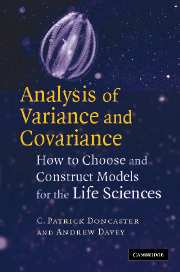Book contents
- Frontmatter
- Contents
- Preface
- Introduction to analysis of variance
- Introduction to model structures
- 1 One-factor designs
- 2 Nested designs
- 3 Fully replicated factorial designs
- 4 Randomised-block designs
- 5 Split-plot designs
- 6 Repeated-measures designs
- 7 Unreplicated designs
- Further Topics
- Choosing experimental designs
- How to request models in a statistics package
- Best practice in presentation of the design
- Troubleshooting problems during analysis
- Glossary
- References
- Index of all ANOVA models with up to three factors
- Index
- Categories of model
Further Topics
Published online by Cambridge University Press: 13 November 2009
- Frontmatter
- Contents
- Preface
- Introduction to analysis of variance
- Introduction to model structures
- 1 One-factor designs
- 2 Nested designs
- 3 Fully replicated factorial designs
- 4 Randomised-block designs
- 5 Split-plot designs
- 6 Repeated-measures designs
- 7 Unreplicated designs
- Further Topics
- Choosing experimental designs
- How to request models in a statistics package
- Best practice in presentation of the design
- Troubleshooting problems during analysis
- Glossary
- References
- Index of all ANOVA models with up to three factors
- Index
- Categories of model
Summary
Balanced and unbalanced designs
Balanced designs have the same number of replicate observations in each sample. Thus a one-factor model Y = A+ε will be balanced if sample sizes all take the same value n at each of the a levels of factor A. Balanced designs are generally straightforward to analyse because factors are completely independent of each other and the total sum of squares (SS) can be partitioned completely among the various terms in the model. The SS explained by each term is simply the improvement in the residual SS as that term is added to the model. These are often termed ‘sequential SS’ or ‘Type I SS’.
Designs become unbalanced when some sampling units are lost, destroyed or cannot be measured, or when practicalities mean that it is easier to sample some populations than others. For nested models, imbalance may result from unequal nesting as well as unequal sample sizes. Thus a nested model Y = B′(A)+ε will be balanced only if each of the a levels of factor A has b levels of factor B′, and each of the ba level of B′ has n replicate observations. For factorial models, an imbalance means that some combinations of treatments have more observations than others. An extreme case of unbalanced data arises in factorial designs where there are no observations for one or more combinations of treatments, resulting in missing samples and a substantially more complicated analysis.
- Type
- Chapter
- Information
- Analysis of Variance and CovarianceHow to Choose and Construct Models for the Life Sciences, pp. 237 - 247Publisher: Cambridge University PressPrint publication year: 2007



